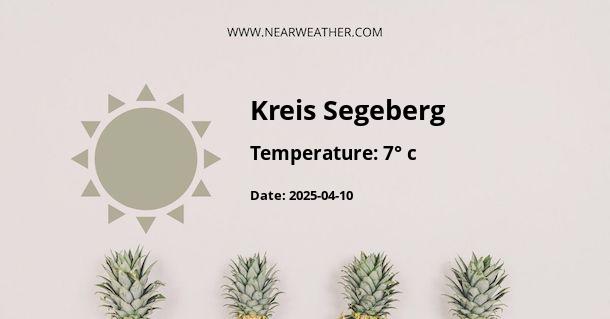Exploring the Climate and Weather of Kreis Segeberg, Germany
The Kreis Segeberg district, positioned in the northern part of Germany within the federal state of Schleswig-Holstein, boasts a temperate maritime climate, typical of the region. This climate is characterized by relatively mild winters, gentle summers, and precipitation spread throughout the year, without a distinct dry season. In this comprehensive guide, we will delve into the climatic nuances of Kreis Segeberg, examining monthly temperature averages, precipitation patterns, and other weather phenomena that influence life in this picturesque locale.
Temperature Overview
The region experiences a moderate temperature range due to its proximity to the Baltic Sea. The maritime influence moderates temperature extremes, leading to a climate that is largely mild compared to other regions at similar latitudes.
| Month | Average High (°C) | Average Low (°C) |
|---|---|---|
| January | 2 | -2 |
| February | 3 | -2 |
| March | 7 | 0 |
| April | 12 | 4 |
| May | 17 | 8 |
| June | 20 | 11 |
| July | 22 | 13 |
| August | 22 | 13 |
| September | 18 | 10 |
| October | 13 | 6 |
| November | 7 | 2 |
| December | 3 | -1 |
Precipitation Patterns
Precipitation in Kreis Segeberg is notably spread throughout the year, with no significant variation in monthly rainfall totals. This leads to a consistent level of humidity and consistently moist soil conditions, which are beneficial for the lush green landscapes of the region.
| Month | Average Precipitation (mm) |
|---|---|
| January | 60 |
| February | 42 |
| March | 50 |
| April | 46 |
| May | 58 |
| June | 78 |
| July | 78 |
| August | 78 |
| September | 65 |
| October | 67 |
| November | 66 |
| December | 68 |
Sunshine and Daylight Hours
As with many regions at high latitudes, Kreis Segeberg experiences significant variation in daylight hours throughout the year. The longest days occur in the summer, primarily around the summer solstice in June, when daylight can last for more than 17 hours. In contrast, December days can be very short, with less than 7 hours of daylight at the winter solstice.
Wind and Weather Phenomena
- Wind patterns: Kreis Segeberg, like much of Northern Germany, is subject to the prevailing westerly winds, which can bring abrupt changes in weather, including quickly transitioning from clear skies to overcast conditions with rain.
- Storms: The autumn and winter months may occasionally be marked by storms, with higher wind speeds and increased precipitation. These storms predominantly come from the North Atlantic and can impact coastal as well as inland areas.
- Fog: Although less common, fog can occur, particularly in the transitional periods of autumn and spring, when temperature differences between day and night can be more pronounced.
Monthly Weather Snapshot
Winter (December - February): The winter months in Kreis Segeberg are characterized by short days and long nights, with temperatures that hover around freezing. Snow is possible, but heavy snowfalls are uncommon. This is a time for visitors to experience traditional German Christmas markets, albeit with the possibility of some rain and snowfall.
Spring (March - May): Spring sees a gradual increase in temperatures and longer daylight hours. The weather can be unpredictable, with a mix of sunny days and periods of rain. Spring is an ideal season for outdoor activities as the natural world awakens from its winter sleep.
Summer (June - August): Summer brings the warmest temperatures of the year to Kreis Segeberg, with highs typically reaching into the low 20s°C. However, it's rarely hot, and the proximity to the sea means that it can be cooler compared to inland areas. This is a great time for outdoor events and to explore the region's natural beauty.
Autumn (September - November): Autumn weather is often pleasant, with mild temperatures and the changing colors of foliage offering a picturesque backdrop. Rainfall is still a common occurrence, making it important to plan for the possibility of wet weather when visiting during this season.
Adapting to the Climate of Kreis Segeberg
The climate of Kreis Segeberg requires a flexible approach to daily life and activities. Given the variability in weather, it is essential to be prepared for a range of conditions:
- Layered clothing is advantageous, as temperatures can shift significantly within a single day.
- Sturdy, waterproof footwear is recommended, particularly for outdoor exploration.
- An umbrella and raincoat are wise additions to any packing list, due to the consistent rainfall throughout the year.
Climate Change Considerations
It's important to note that, like much of the world, Kreis Segeberg is not immune to the effects of climate change. Regional variations in climate patterns may lead to increased frequency of extreme weather events, including storms, and changes in temperature and precipitation averages. Thus, local and regional authorities constantly monitor and adapt to these evolving climate conditions.
The climate and weather patterns outlined for Kreis Segeberg offer a tapestry of experiences for residents and visitors alike. While the pleasant summers and snowy winters provide a range of recreational opportunities, the consistent rainfall and moderate temperatures ensure that the region remains a verdant space throughout the year.
A - Kreis Segeberg's Latitude is 53.954720 & Longitude is 10.187220.
A - Weather in Kreis Segeberg is 15° today.
A - Climate Conditions in Kreis Segeberg shows overcast clouds today.
A - Humidity in Kreis Segeberg is 80% today.
A - Wind speed in Kreis Segeberg is 8.5 km/h, flowing at 249° wind direction. today.
